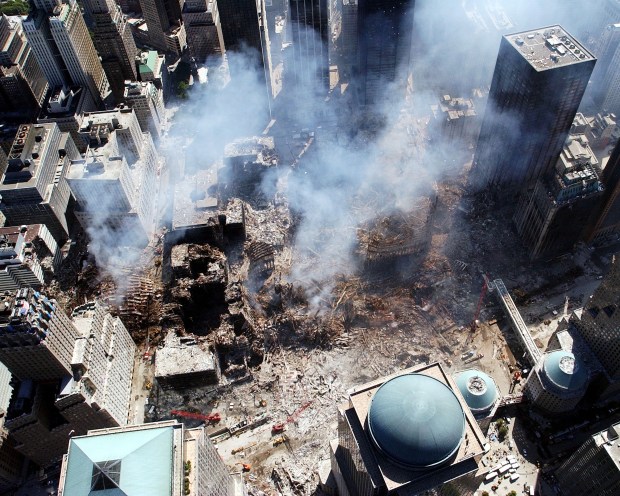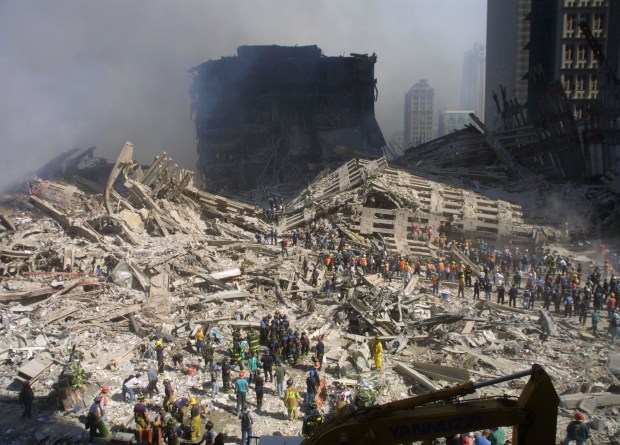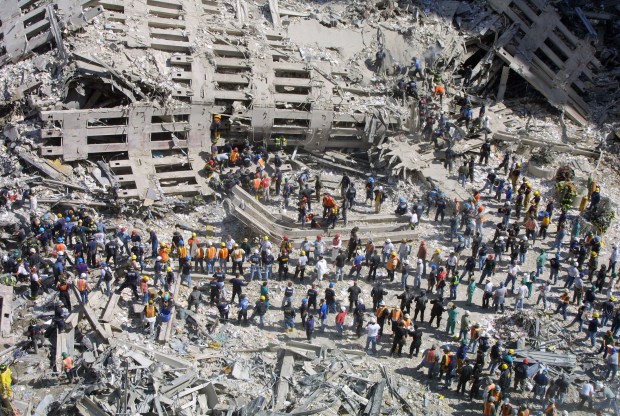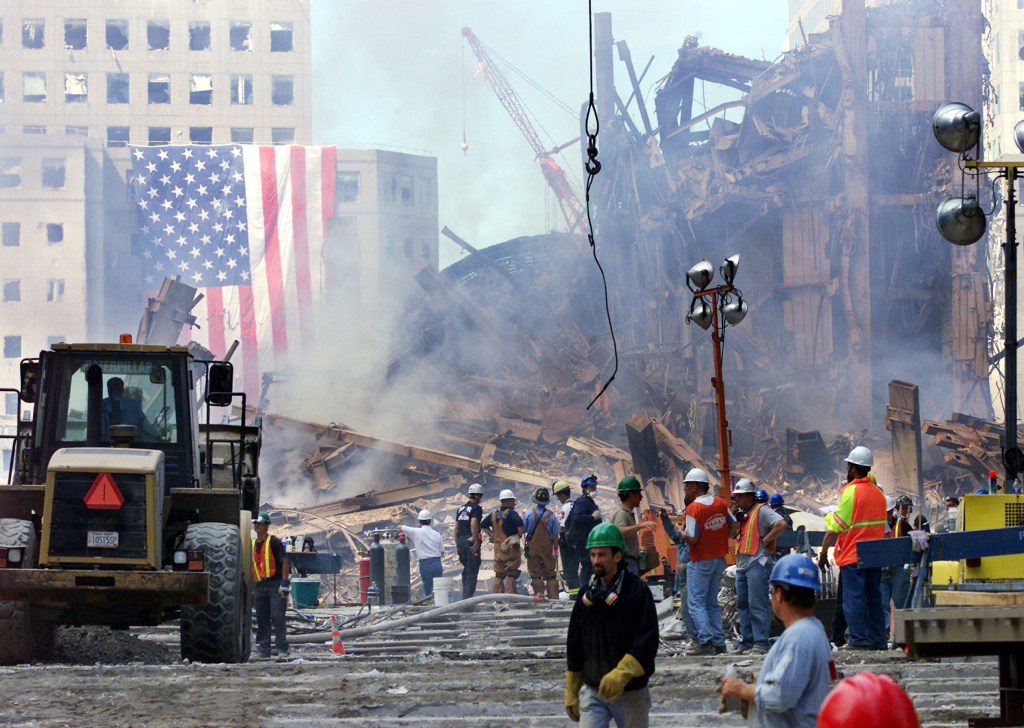After claiming for years that they couldn’t find any documents about what City Hall knew about the dangers of the 9/11 toxins swirling around Ground Zero, the city Department of Environmental Protection has now discovered 68 boxes worth of information that could be pivotal in learning more about what first responders and survivors were exposed to, the Daily News has learned.
The materials, ironically, included a directive from the city Law Department written two decades ago ordering the agency to save and preserve any information about the terror attacks and its aftermath that could be used in future litigation, said Andrew Carboy, an attorney representing 911 Health Watch, a responder and survivor advocacy group.
“We’re witnessing pure alchemy, creating documents from absolutely nothing! It’s a fantastic feat, pure magic,” he said sarcastically. Carboy has been trying to get his hands on the 9/11 documents, only to be repeatedly told that the city didn’t have any to share.
The fact that the DEP had nearly 70 boxes of information and were ordered to preserve the documents two decades ago directly contradicts what the city has been claiming for so long, Carboy said.
“The city of New York at some point went wildly off the tracks in a way that is contrary to law, due process and the norms of professional conduct,” said Carboy.
“They took part in a systematic and coordinated effort to keep this information from us. How dare they do this.”
 An aerial view shows only a small portion of the crime scene September 16, 2001 where the World Trade Center collapsed following the September 11, 2001 terrorist attack in New York City. Surrounding buildings were heavily damaged by the debris and massive force of the falling twin towers. Clean-up efforts are expected to continue for months. (Photo by Eric J. TIlford/U.S. Navy/Getty Images)
An aerial view shows only a small portion of the crime scene September 16, 2001 where the World Trade Center collapsed following the September 11, 2001 terrorist attack in New York City. Surrounding buildings were heavily damaged by the debris and massive force of the falling twin towers. Clean-up efforts are expected to continue for months. (Photo by Eric J. TIlford/U.S. Navy/Getty Images)
The Uniformed Firefighters Association, the union that represents city firefighters, was “beyond outraged to learn that after decades of claiming no records existed, the City of New York and the DEP were actually sitting on 68 boxes of documents about the poisons we were breathing (on 9/11),” union president Andrew Ansbro said.
On the day of the terror attacks, 343 FDNY members died in the collapse of the Twin Towers. Since then, an additional 400 members have died of 9/11-related illnesses linked to the toxins they were breathing at Ground Zero.
“This isn’t just missing paperwork — this is a betrayal of the men and women who risked everything on 9/11 and have been dying ever since,” Ansbro said. “For years, our members made life-and-death medical decisions based on the city’s repeated assurances that the air was safe and there were ‘no records.’ Now we learn there were tens of thousands of pages locked away — pages that could have changed treatment plans, sped up diagnoses and maybe even saved lives.”
Carboy and reps from 911 Health Watch went to the DEP offices the week of Nov. 17 to go through more than 20 of the boxes that were ready to be reviewed. The boxes were in good shape and well organized, said City Councilwoman Gale Brewer (D-Manhattan), who joined Carboy.
She, too, had repeatedly requested the documents, but never got anywhere until this year, when she pushed through legislation ordering the city’s Department of Investigation to launch a probe over what and when the city knew about the toxins that have sickened or killed thousands of first responders.
“They were very responsive,” Brewer said about DEP staffers who provided the boxes. “They gave us the conference room. They said they never had such excitement on the seventh floor before.”
“I don’t know where they were, but they were in good shape, even though it was a little Johnny come lately,” Brewer said. “I don’t know what took so long after all the letters and (Freedom of Information Law) requests to the DEP and other agencies.”
While happy the documents were turned over, Benjamin Chevat, Executive Director of 911 Health Watch said the agency’s decision to share these boxes after the DOI started their probe wasn’t lost on him.
“It’s a miracle! From zero to 68 boxes!” Chevat joked. “This discovery coming weeks after Councilwoman Brewer successfully got the City Council to order the NYC Department of Investigations to review what the City knew about the hazards of the toxins at Ground Zero. Coincidence? I think not.”
“We know from the Daily News reporting that DOI Commissioner Strauber moved swiftly to start the investigation, already reaching out to City Agencies and collecting documents,” Chevat said. “Hopefully incoming Mayor Mandami will ensure that the DOI has the resources to complete its work before the upcoming 25th Anniversary of the 9/11 attack.”
 Rescue workers sift through the wreckage of the World Trade Center September 13, 2001 in New York City, two days after two hijacked airplanes slammed into the twin towers, levelling them in an alleged terrorist attack. (Photo by Mario Tama/Getty Images)
Rescue workers sift through the wreckage of the World Trade Center September 13, 2001 in New York City, two days after two hijacked airplanes slammed into the twin towers, levelling them in an alleged terrorist attack. (Photo by Mario Tama/Getty Images)
The News story, published as the city marked the 24th anniversary of the terror attacks, disclosed that only eight weeks into the DOI’s review, the response was so overwhelming the agency was looking at the possibility of getting outside help to parse through all the data.
For months, the city has tried to quash a lawsuit Carboy filed in an effort to pry loose the data. City attorneys said the DEP didn’t have any documents to share and called the search nothing more than a “fishing expedition.”
“After a diligent search was performed of DEP’s records, no responsive records were found,” city attorneys claimed in court papers at the time.
But, after the DOI probe began, the city announced it actually did have some boxes to share. At first Carboy was told the DEP had 40 boxes. When they showed up at the DEP offices on Monday, there were 68.
The city Law Department didn’t see an issue with the DEP’s sudden about face.
“The city’s FOIL response reflected what was true and accurate at the time: DEP couldn’t locate hard copy documents,” Law Department spokesman Nicholas Paolucci said. “That has since changed and we have a schedule in place to produce documents.”
Brewer wrote the resolution that the full council unanimously passed on July 14, ordering the DOI to probe what information the city had on Ground Zero toxins after the 9/11 attacks and when they had it. It marks the first time a provision of the City Charter allows the Council to order the DOI to undertake an investigation with a bill.
 Rescue workers sift through the wreckage of the World Trade Center September 13, 2001 in New York City, two days after two hijacked airplanes slammed into the twin towers, levelling them in an alleged terrorist attack. (Photo by Mario Tama/Getty Images)
Rescue workers sift through the wreckage of the World Trade Center September 13, 2001 in New York City, two days after two hijacked airplanes slammed into the twin towers, levelling them in an alleged terrorist attack. (Photo by Mario Tama/Getty Images)
The DOI sent out letters to every agency, asking them to identify and turn over any relevant documents they had on 9/11 toxins following the terror attacks. Nearly all of the agencies contacted have responded to the DOI’s request, officials said.
The Adams administration as well as its predecessors, have fought the release of any 9/11 studies and documents, claiming they couldn’t find them. The city has also repeatedly said it was worried about a barrage of lawsuits from survivors and first responders suffering from 9/11 illnesses if the documents were released.
More than 140,000 first responders and survivors are enrolled in the U.S. Center for Disease Control’s WTC Health Program, which provides health care benefits for medical conditions related to exposure to the toxins that hung over Ground Zero. Out of that number, about 81,000 have a certified condition linked to the toxins that hung above Ground Zero.
The unearthed documents won’t likely cause a flurry of lawsuits since first responders and survivors who are receiving help from the WTC Health Program and the 9/11 Victim Compensation fund have already signed waivers agreeing not to sue over their illnesses. More than 100,000 have signed these waivers, officials said.
